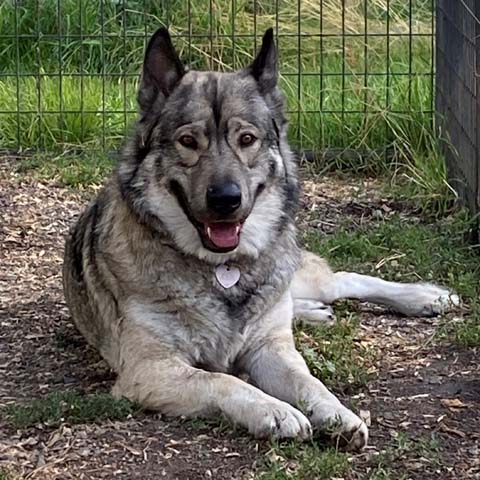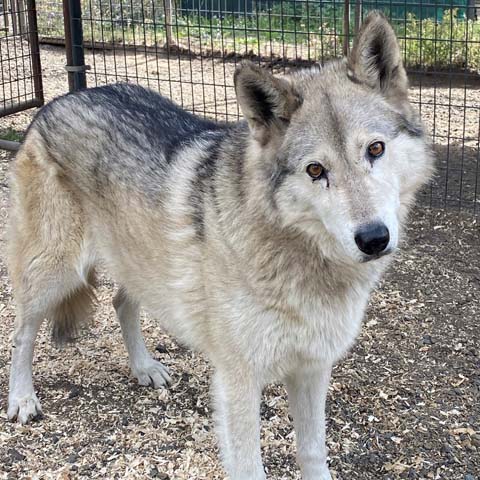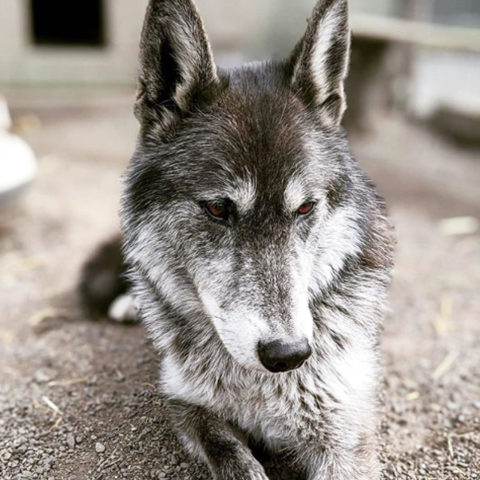A wolfdog is a hybrid animal that is a cross between a domestic dog and a wolf. Wolfdogs are also known as wolf hybrids. These animals can vary widely in terms of their appearance, behavior, and temperament, depending on the breed of dog and type of wolf that is involved in the crossbreeding. Wolfdogs can have physical and behavioral traits that are characteristic of both wolves and dogs, and they can range from low-content to high-content animals. Wolfdogs can make challenging pets, as their behavior can be unpredictable and they require specific care and attention. In some places, it may be illegal to own a wolfdog due to concerns about their behavior and potential danger to humans and other animals. Wolfdog hybrids as a pet are illegal in 12 states and regulated by local laws in 27 others.
Gray Wolf – Canis lupus
Habitat: North America and Eurasia
Lifespan: Wild 6-8 years; Captivity 12-16 years
Diet: Carnivores
Status: Endangered in the United States
Wolves are the largest members of the dog family. They occupy a range of habitats including Arctic tundra, prairies and forests. They live and hunt in packs of around six to ten animals. Wolves are known to roam large distances, perhaps 12 miles in a single day. You may feel a little scared when you hear a wolf howl- but it doesn’t howl to frighten you. Howling is a wolf’s way of communicating. A lone wolf howls to attract the attention of his pack, while a pack will howl together to send a message to another pack.
Wolves weigh between 80 and 100 lbs and are very similar in general appearance and size to the German shepherd, which is a very popular pet. The color of wolves vary from pure white, through mottled gray to brown or black. However, grizzled gray is the most common color. Wolves prey on large animals such as deer, elk, and moose, as well as smaller mammals, birds, fish, lizards, snakes, and fruit. Wolves are also scavengers and often eat animals that have died due to other causes like starvation and disease.
Wolves once had the largest natural distribution of any mammal except humans. However, they can no longer claim this record as they have been driven out from much of their former lands. They have also been hunted relentlessly and so their numbers are going down.
- After a successful kill a wolf may eat 20 pounds of meat at one go because it never knows when it will get a good meal again.
- Adult gray wolves have 42 teeth, compared to 32 teeth for adult humans
- In 1926, the last wolf was killed in Yellowstone National Park. A wolf reintroduction program was implemented in 1995. The program is considered to be a great success – the wolves are reproducing at a rapid rate, and there are currently around 100 wolves in the park.
- Many Native American and Inuit tribes revere the wolf as a brother and fellow hunter. They have great respect for the wolf and will never speak badly about it.
Meet Our Wolfdogs

Fancy
Fancy arrived by airplane from across the United States in May of 2022, Cat Tales Wildlife became Fancy’s fourth (but now permanent & forever) home. As is the case with many of this cross breeding, the puppies are adorable but soon grow into their wolfiness. Illegal in many places, wolfdogs often are bounced from one home to the next. This constant change in ownership causes behavioral issues that are common in hybrids. In Fancy’s case she is timid & just re-learning trust. Now that she lives side by side with the other wolfdogs she is finding her comfort zone and allowing some keeper tactile contact on Fancy’s own terms. Born March 8, 2019
Fancy’s DNA (top 5) – 29% Siberian Husky, 24% Alaskan Malamute, 17% Wolf, 11% Border Collie, 4% Chow Chow

Akeylah
Akeylah came to us from a private owner in the Spokane area. She was kept chained up in her owner’s yard and frequently escaped her lead. For fear of being shot by neighbors while also suffering from an inflamed wound caused by her chain and having gone untreated, she was handed over to us in spring of 2018 and long-term treatment was provided for her. Although she seems very dog-like, she still has the capacity to cause significant damage and will be treated with the utmost precaution here at Cat Tales. Born 2011
Akeylah’s DNA (top 5) – 28% Wolf, 22% Alaskan Malamute, 20% Siberian Husky, 8% German Shepherd Dog, 7% Chow Chow

Grae
Grae was born in a wolf-hybrid rescue center in Oregon. Her 3rd owner contacted us after visiting Cat Tales and heard about our northwest native species exhibit. She knew Grae was not suited for living in a residential situation and hoped that she could be an addition to our exhibit or somewhere in our facility where Grae could have a better home more suited to her genetics. Born 06/13/2015.
Grae’s DNA – 50% Gray Wolf, 25% Siberian Husky, 12.5% Alaskan Malamute, 12.5% German Shepherd Dog


